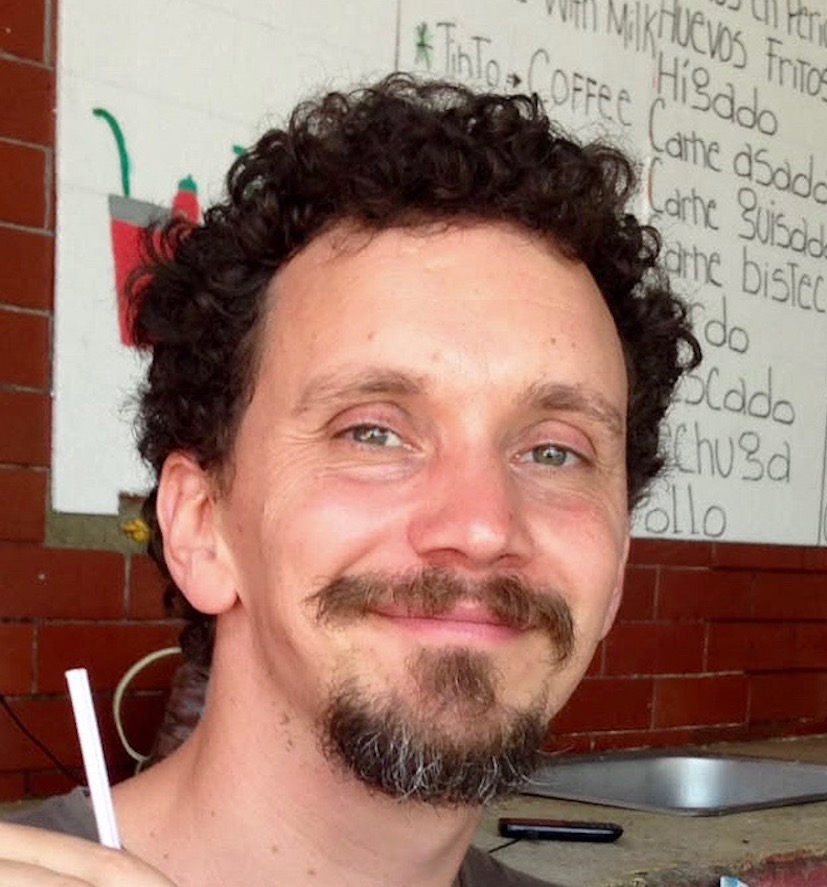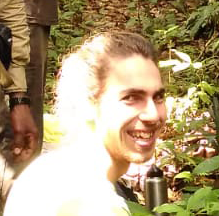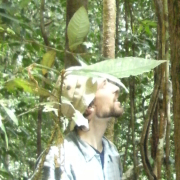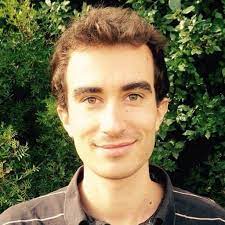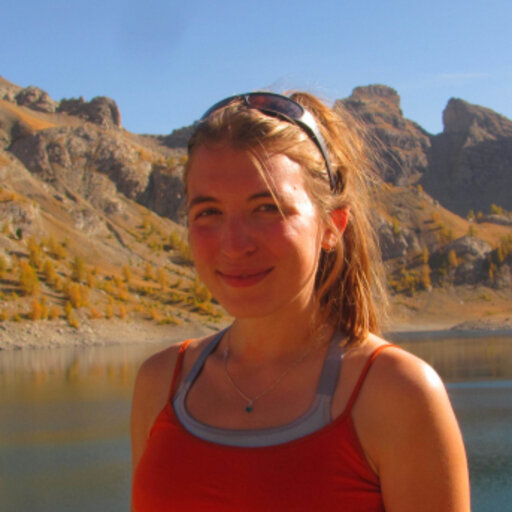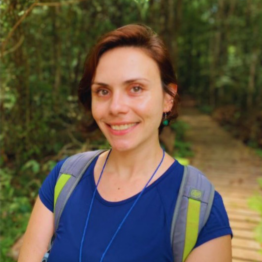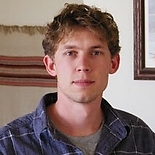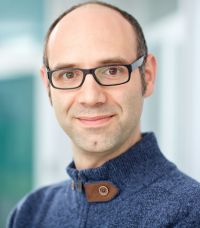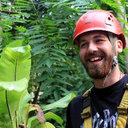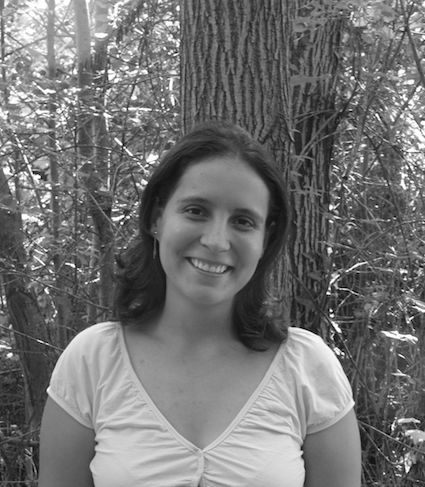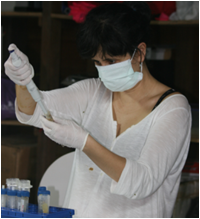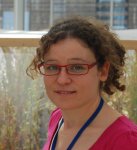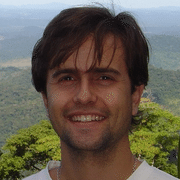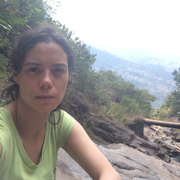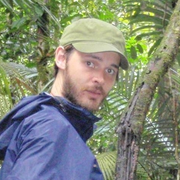Tropical forest biodiversity
Our group studies the interactions among levels of ecological integration. Tropical forests have long served as a testing ground for ecological theories. We are combining field research, molecular biology, and mathematical modeling to explore the mechanisms proposed to explain biodiversity, biogeochemical cycling, and macroevolutionary patterns.
Jerome Chave
Directeur de Recherche CNRSPublications on Google Scholar
PhD in physics from Orsay University (1999) and engineer diploma from Ecole Centrale Paris (1995).
Deputy Director of Centre de Recherche Environnement Biodiversite CRBE UMR 5300. Member of the French Académie des Sciences. Coordinator of LabEx CEntre for the study of Biodiversity in Amazonia Labex CEBA. Coordinator of the GEO-TREES initiative GEO-TREES. Associate director of PEPR FORESTT initiative FORESTT. Scientific director of the Nouragues Ecological Research Station, French Guiana.
CRBE • GEO-TREES • FORESTT• Nouragues • Labex CEBA
Projects
Remote sensing of tropical forests. Novel Earth Observation techniques offer a sub-metric description of natural forest ecosystems (aerial and terrestrial lidar) and could also be used to map forest carbon stores globally (P-band radar technology). We have been involved in the preparation missions of the BIOMASS Earth Observation satellite, to be launched in April 2025, and are contributing methods for algorithm training and product validation, especially within the Group of Earth Observation's GEO-TREES initiative, and the One Forest Vision initiative. • BIOMASS mission • GEO-TREES• One Forest Vision
Biomass and tropical tree allometry. Trees display a fascinating diversity in shape and architecture. We have compiled destructive harvest experiments across tropical forests where trees have been cut and their parts individually sampled. This dataset has been instrumental to develop novel allometric equations that are used worldwide to estimate aboveground carbon stocks in mixed-species tropical forests (Chave et al. Global Change Biology 2014). Our research includes attempts to better understand other allometric relationships (Paul et al. Global Change Biology 2016; Jucker et al. Global Change Biology 2016).
• Pantropical allometry database • Pantropical allometry paper •
Wood density. Wood density is an important functional trait in plants and it is easily measured across woody plants. Over years, we have assembled a global wood density database for tropical forest sites (Chave et al., Ecology Letters 2009). We have also produced a tutorial for wood density measurement, updated by the Rainfor and ForestGEO consortia. The global wood density database is now aggregated to the TRY database. • Wood density handbook • Wood density database • Wood density paper •
Neutral theory of biodiversity. Theoretical community ecology has long been elaborated around the notion of the niche. In the early 2000s, the idea that community assembly is shaped more by the stochastic nature of demography and dispersal than by deterministic factors has come to the fore. The neutral theory of biodiversity and biogeography developed by SP Hubbell has two parameters (theta, a regional diversity parameter; and m an immigration rate). With Franck Jabot, we have developed software to infer the parameters of Hubbell's model. The first code, tetame, implements Rampal Etienne's method of statistical inference by maximum likelihood estimation. The second, parthy, infers the parameters in a non-neutral biodiversity model using Approximate Bayesian Inference. More recently, the neutr package for the R language has been published. • TETAME • PARTHY •NEUTR •
Biodiversity theory and plant functional traits. Niche theory predicts that in a local community, each species possesses a unique combination of traits (the species niche), to avoid interspecific competition. In contrast, neutral theory of biodiversity ascribes no role to competition and niches for local species coexistence. This project has assembled a unique database combining ecological, physiological, and genetic information in several tropical forest tree communities of French Guiana and has tested existing theories of biodiversity by combining field data and novel modelling approaches. We sampled nine old-growth forest tree plots and measured many plant functional traits; we also produced a phylogenetic hypothesis for the tree species found in our plots (Baraloto et al. 2012). The plant functional trait database is now included in the TRY portal and freely accessible (ANR-funded BRIDGE project 2007-2011). • Functional trait database • BRIDGE project website •
Metabarcoding and environmental DNA biodiversity surveys. Sequencing technologies are evolving at a fast pace and offer unique opportunities to help improve biodiversity surveys. We combined concepts from metagenomics (analysis of cellular microbial DNA from the soil) and from DNA barcoding (use of small DNA fragments that serve to discriminate among species) and developed innovative protocols to standardize the acquisition of high-throughput biodiversity data. These protocols were tested in two large-scale experiments, including broadly different environmental conditions (alpine and tropical), and taxonomic groups (ANR project METABAR; 2012-2016; PI Pierre Taberlet ; ANR project GLOBNETS; 2018-2023; PI Wilfried Thuiller). • METABARCODING •
Phylogenetics from plant organelle genomes. Evolutionary relationships among species shed light on the pace of diversification and on major events that have underpinned the extant biodiversity of our planet. We used next-generation sequencing technology to assemble full chloroplast genomes of several lineages of tropical forest plants. Our first project has focused on the lesser known family Chrysobalanaceae, frequent as trees in Amazonian forests, and for which a recent systematic treatment is available (Prance and Sothers 2003). We produced sequence data for over 25% of the known species in this family and showed that the family originated from Asia but diversified mostly in Amazonia over the past 30 million years (Bardon et al., American Journal of Botany 2016; Chave et al., Bot J Linn Soc 2020). We have recently exntended this work to the Lecythidaceae, another family of Amazonian trees (Chave et al. Botany Letters 2024), and will include other families: Sapotaceae and Humiriaceae. • Chrysobalanaceae phylogeny • Lecythidaceae phylogeny •
Useful links
•
Networks:
ForestGEO •
ForestPlots.net (AfriTRON, RAINFOR) •
Amazon Tree Diversity Network •
Data resources:
NASA Earthdata •
Worldclim •
ERA5-Land hourly data from 1950 to present •
Harmonized World Soil Database •
Angiosperm Phylogeny website •
World Flora Online •
Royal Botanic Gardens, Kew, databases •
Missouri Botanical Garden, Tropicos •
Software:
QGIS •
The Comprehensive R Archive Network •
Current group
Raphaël Garisoain
Raphaël is a post-doctoral associate of the group. He holds a PhD in ecological modelling from Universite de Toulouse. His current work explores the multilayer representation of forest microclimates within the TROLL model.Gabriel Hes
Gabriel is a doctoral student co-supervised with Jerome Ogee in Bordeaux. His project is to explore and model the response of plants to the peculiar microenvironmental conditions of the forest understory. This project is related to the ANR projects ALT and MaccMic, and is funded by a fellowship of Ecole Normale Superieure.Nicolas Labrière
Nicolas is a research associate funded by ESA. He holds a PhD from AgroParisTech, and has extensive experience in forest monitoring in Borneo, the Amazon and Gabon. He is contributing to the global effort of collecting in situ biomass data for the Forest Observation System. He is currently the coordinator of the MONITOR project (PEPR FORESTT).Julien Lamour
Nicolas is a post-doctoral research associate funded by the NGEE-Tropics projet (US Department of Energy). He is a plant ecophysiologist, and holds a PhD from Universite de Montpellier. He is interested in the response of photosynthesis to light and water availability.Ayala Loisel
Ayala is the science coordinator of the GEOTREES initiative, a position funded by CNES. She holds a PhD in ecology from Université Aix-Marseille. GEOTREES is supported by ESA, NASA, CNES and CEOS.Marina Longoni
Marina holds a Msc in environmental engineering from Milan University, with a specialization in environmental monitoring. She works on laser scanning applications for forests within the GEO-TREES project. Her position is supported by the FRM4BIOMASS ESA project.Karl Montalban
Karl is a data analyst part of the GEO-TREES project. Before this he did a PhD on lidar applications in Toulouse and a postdoc inCanada.Béatrice Roy
Béatrice is the science project manager for Labex CEBA. She was previously project manager at Universite Federale de Toulouse.Bianca Rius
Bianca is a post-doctoral associate of the group. He holds a PhD in ecological modelling from State University of Campinas. Her current work explores the role of the soil water table on forest dynamics within the TROLL model.Valentina Soto Minutti
Valentina holds a Msc from Toulouse University and is a PhD student in the group. Her research is on edge forests and their influence for biodiversity and biogeochemical cycles. She is funded by CNRS.
Group alumni
Léa Bardon (doctoral student 2011-2015)
A former Msc student at Univ Toulouse, Léa worked on the phylogeny of a pantropical family of woody plants, Chrysobalanaceae. She applied plastid genome sequencing techniques to resolve the phylogenetic tree for this family, and used extant species to infer the ancestral areas for lineages. She is now a biology teacher.
Oskar Burger (postdoc 2008-2009)
Oskar was involved in an NSF-funded project on Coupled Human-And-Environment System (CHANS) in Guyana, led by Jose Fragoso. He did another post-doc at the Max Planck Institute for Demographic Research in Germany, and held a position at University of Kent, UK. He was program manager at University of Texas, Austin, as is now senior research manager at OMNI.
Guillem Chust (postdoc 2002-2004)
Guillem conducted his PhD research at CESBIO in Toulouse. As a PDRA with us, he was funded by CNRS and worked on ordination methods for the study of betadiversity in tropical tree species. More recently, we collaborated of the neutral theory of biodiversity applied to planktonic marine samples. He is now Senior Researcher at ATZI, Bilbao.
Elodie Courtois (doctoral student 2006-2010; postdoc 2014-2015)
Elodie holds a Msc from INSA-Lyon and a PhD from Toulouse University in chemical ecology (PhD: The perfume of plant defense in Amazonian forests). After a post-doc in Moulis on the chytrid amphibian disease, she was PDRA in the group, hosted at CNRS-Guyane, and funded by the ANAEE-France project, then at University of Antwerp in Ivan Janssens' lab. She has been Research Engineer at CNRS in French Guiana, and is now an independent researcher.
Vincent Dehaye (engineer, 2022-2023)
Vincent was in charge of the terrestrial lidar scanning project. He holds and engineer degree from ISAE-ENSMA, Toulouse. He is now at CESBIO, Toulouse.
Jessica Delhaye (Labex CEBA 2017-2019)
Jessica was the science project manager for Labex CEBA. She did a PhD at Lausanne University on avian malaria. At CEBA she was instrumental in setting up the strategy for the CEBA2 project, post 2020.
Kyle Dexter (postdoc 2009-2011)
Kyle graduated from Duke University on the ecology and biogeography of the Neotropical legume genus Inga. In the group, he contributed to the ANR-funded project BRIDGE, and developed large-scale analyses of traits across the Neotropics. He is now senior Lecturer at University of Torino.
Iris-Amata Dion (staff 2022-2024)
Iris was the science coordinator of the GEOTREES initiative, funded by CNES. She holds a PhD in atmospheric sciences from CNRM and LEGOS labs in Toulouse.
Julian Donald (postdoc 2018-2021)
Julian was a post-doctoral research associate funded by the ANR-FRS funded project SECIL. His project was on patterns of endophytic community assembly in tropical leaves and roots. He completed his PhD at University of the West of England, Bristol on rainforest canopy science. He was a lecturer at University of Exeter, UK.
Fabian Fischer (doctoral student 2016-2020)
Fabian ws a PhD student from April 2016 to December 2019, funded by the Studienstiftung des deutschen Volkes e.V.. He holds degrees in literature, philosophy and physics from Ludwig-Maximilians-Universität, Munich.
He was studying inverse modelling approaches using the individual-based forest simulator TROLL. After a postdoc at University of Bristol, UK, he is now a postdoc at Technical University of Munich.
Rosie Fisher (postdoc 2019-2021)
Rosie was a NGEE-Tropics personnel, and modelling lead of the FATES model. She joined the group in 2019, to continue her work with the development of FATES, before accepting a senior researcher position at CICERO, Norway.
Mailyn Gonzalez (doctoral student 2005-2009)
Mailyn holds a Msc from University of Lausanne. As a PhD student in the group, she spearheaded our first attempts to develop a functioning plant DNA barcode system for Amazonian trees, and studied the regeneration of trees in French Guiana. She is now Investigador at Instituto De Investigacion De Recursos Biologicos Alexander Von Humboldt in her homeland Colombia.
Amaia Iribar (Labex CEBA 2012-2018)
Amaia holds a Msc in ecology and a PhD in environmental microbiology, both from Toulouse University. She was the science project manager for Labex CEBA, and is now appointed as CNRS Research Engineer at CRBE, where whe coordinates the microbiology and molecular biology platform (B2M).
Franck Jabot (doctoral student 2005-2009)
Franck holds a diploma from Ecole Polytechnique. During his PhD project he worked on improving inference methods for Hubbell's neutral theory of biodiversity. He developed new techniques based on the Approximate Bayesian Computation method. He is now staff researcher at INRAE, Clermont-Ferrand, and head of the LISC lab.
Coline Jaworski (doctoral student 2011-2015)
Coline holds a diploma from Ecole de Physique Chimie de Paris, with a background in chemistry. Her PhD was on the eco-evolutionary dynamics of species interactions. She developed experiments to assess floral scent-mediated interactions between Antirrhinum majus (snapdragon) and pollinating insects. She was research associate at University of Oxford and Sophia Antipolis.
Emilie Joetzjer (postdoc 2017-2018)
Emilie was a post-doctoral research associate supervised by Philippe Ciais, funded by CEA. Previously, she was a PhD student in Meteo-France in Toulouse, and has contributed a critical reanalysis of the current and future precipitation predictions of global climate models over the Amazon basin. After work with us on the global dynamic vegetation model Orchidee, she is now tenured scientist at INRAE Nancy.
Renato Lima (postdoc 2015-2016)
Renato was a post-doctoral associate in the group, funded by Fundacao de Amparo a Pesquisa do Estado de Sao Paulo. He holds a PhD in ecology from Universidade de Sao Paulo. He was a Marie Curie fellow at Naturalis Leiden, at CESAB Montpellier, and is now tenured professor at ESALQ, Piracicaba.
Pierre-Jean Malé (postdoc 2011-2013)
PJ holds a Msc from Montpellier University and a PhD from Toulouse University, where he worked on ant genetic systems. As a post-doc in the group, he worked to develop early methods of transcriptome sequencing in tropical plants, and plastid genome sequencing by Illumina shotgun sequencing. He is now Senior strategist at BEworks, Canada.
Isabelle Maréchaux (doctoral student 2013-2016, postdoc 2017-2018)
Isabelle was trained at Ecole Polytechnique and is Ingénieur des Ponts, Eaux et Forêts (the funding body for her PhD). She contributed to the development of an individual based model of tropical forests. She was then a post-doc in the group, jointly with that of Frans Bongers at Wageningen University. She is now staff scientist at INRAE in Montpellier.
Victoria Meyer (doctoral student 2012-2017)
Victoria was a PhD student, co-supervised by Sassan Saatchi in Los Angeles. She holds a Msc from Bordeaux University. She is working on the potential of LiDAR data to recover biomass and forest structure information in old-growth tropical forests. She was based at the Jet Propulsion Laboratory in Pasadena for a post-doc (NASA/CalTech) and is now employed by Terraformation, USA.
Andrés Gonzalez Moreno (engineer 2024-2025)
Andrés was a data scientist with the GEO-TREES project. He developed new tools for the analysis of lidar scanning data. He was previously an engineer at Easymile, Toulouse. His position was supported by the FRM4BIOMASS project of ESA.
Natalia Norden (doctoral student 2003-2007)
Natalia holds a Msc from Paris. Her PhD in Toulouse, co-supervised with Christophe Thebaud, was on the quantification of seed-to-seedling transition in Neotropical trees and lianas. She was then post-doc at the University of Connectitut in Robin Chazdon's lab, then professor at the Universidad Javeriana, Bogota, her hometown. She is now Investigador at Instituto De Investigacion De Recursos Biologicos Alexander Von Humboldt in Bogota.
Laetitia Plaisance (project manager 2019-2023)
Laetitia was the science project manager for Labex CEBA. She holds a PhD from Perpignan University, where she studied the biogeography and phylogeny of lionfish in the Pacific Ocean. She then moved for post-doctoral fellowships at the National History Museum in Oslo, Norway, then at the Scripps Institute, San Diego, USA. From 2013, she was the coordinator og the Marine Biodiversity Program at the National History Museum, in Washington DC.
E-Ping Rau (doctoral student 2016-2022)
E-Ping holds a Msc from Taipei University, Taiwan. His PhD project was to explore the response of tropical rain forests to extreme wind events using a novel implementation of the TROLL model, and with data from Sentinel 1. He is now a postdoc at Cambridge University.
Maxime Réjou-Méchain (postdoc 2010-2013) Maxime graduated from University of Montpellier where he worked on the dynamics of forests at the CIRAD M'Baiki station, in the Republic of Central Africa. In the group, he worked on the phylogeny of trees of M'Baiki, and on biomass estimation of tropical forests using aerial LiDAR scanning. He then moved to India, to led a remote sensing lab of the Institut Francais de Pondichery, and is now senior staff scientist at IRD, Montpellier (AMAP).
Guilhem Sommeria-Klein (doctoral student 2013-2017)
Guilhem was a PhD student and worked on theoretical models of biodiversity adapted to the study of spatially explicit DNA-based biodiversity inventories. He was then a post-doc in Hélène Morlon's group (CNRS Paris), and is now lecturer at University of Turku, Finland.
Claire Suchet (doctoral student 2006-2010)
Claire holds a Msc from Toulouse University. As a PhD student, she worked on unravelling the smell of wild snapdragon populations in the Pyrenees, in collaboration with Christophe Thebaud and Christine Raynaud.
Tony (Shengli) Tao (postdoc 2018-2022)
Tony was funded by Labex CEBA.
He did his PhD in Beijing University on remote sensing applications to carbon stock assessment, and wants to study the spatially-explicit modelling of Amazonian communities. He is now a lecturer in Beijing University.
Blaise Tymen (doctoral student 2013-2016)
Blaise was trained at Ecole Normale Supérieure de Lyon in biology (funding his PhD). Until December 2015, Blaise was PhD student in the group, co-supervised by Grégoire Vincent (Montpellier). He is now post-doc in the group. His research focuses on applications of aerial LiDAR scanning to detect vegetation structure. He is now a biology teacher.
Lucie Zinger (postdoc 2013-2016)
Lucie is a expert in bioinformatics and microbiology, she was involved in the ANR-funded METABAR project, which developed DNA-based techniques for biodiversity inventory both in the tropics and the temperate zone. She holds a Msc and PhD from Grenoble University (Variations spatio-temporelles de la microflore des sols alpins). She was assistant professor at Ecole Normale Superieure, rue d'Ulm, Paris, and is now a staff scientist at CNRS.
